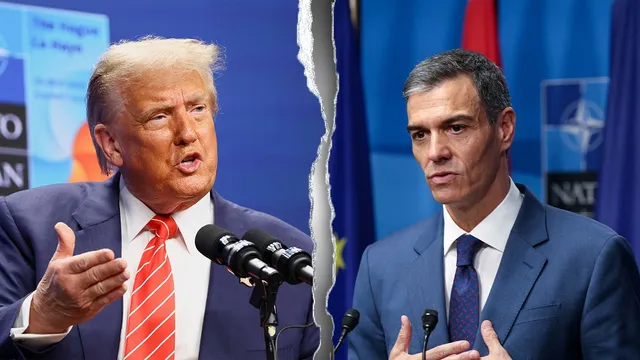
Trump pushes NATO allies to adopt 5% defense spending target
2025-06-25 15:30- During the NATO summit in The Hague, President Donald Trump addressed international security issues, specifically urging allies to increase defense spending.
- Despite Spain's alternative contribution of 2.1% of GDP, most NATO members appear willing to support Trump's proposal for 5% defense spending.
- This summit reflects ongoing shifts within NATO as member states respond to external threats and U.S. expectations regarding defense contributions.
Express your sentiment!
Insights
The NATO summit took place in The Hague, Netherlands, on June 24, 2025, where President Donald Trump addressed pressing defense issues in light of recent geopolitical tensions. Tensions were heightened after U.S. airstrikes on Iranian nuclear facilities prompted a fragile ceasefire between Israel and Iran, showcasing Trump's influence in international diplomacy. During the summit, Trump urged NATO allies to significantly increase their defense spending, proposing a target of 5% of GDP, more than double the current guideline of 2%. He emphasized that the U.S. bears a disproportionate share of NATO’s defense burden but expressed his belief that the U.S. does not need to meet this target. Trump's proposal reflects long-standing criticisms he has directed at European nations and other NATO allies regarding their military contributions. NATO Secretary General Mark Rutte supported the president’s push for increased spending, highlighting the importance of strengthening defense capabilities against various global threats, including those posed by Russia. Despite Spain's prime minister announcing an alternative arrangement to contribute only 2.1% of GDP, the summit concluded with a general agreement among most NATO members to commit to the new spending target. However, doubts linger regarding the U.S. fidelity to NATO's mutual defense commitments, especially after Trump's ambiguous remarks about Article 5 of the NATO treaty. The backdrop for these developments includes Russia's increasing assertiveness and its portrayal as a major threat by NATO members. Amid these tensions, the sum of military expenditures is viewed as crucial for ensuring stability within the alliance and addressing ongoing conflicts with nations such as Russia and Iran. Moreover, amid rising global insecurity, NATO leaders recognized the necessity of adapting to new threats, thereby emphasizing the relevance of modern defense spending strategies. As a consequence, it appears that the member states are beginning to shift their defense policies in reaction to U.S. pressure as well as in response to changing international security landscapes, marking a significant moment in NATO's evolution. In conclusion, while Trump has long been critical of NATO’s financial dynamics, his recent proposals and the subsequent agreements signify a turning point in the alliance's approach to defense spending. The increased emphasis on financial contributions raises questions about sustainability and commitment within the alliance as its members navigate complex geopolitical challenges.
Contexts
NATO's Article 5 serves as the cornerstone of the North Atlantic Treaty Organization's collective defense arrangement. This principle, rooted in the idea that an armed attack against one member is treated as an attack against all, underscores the mutual security commitments of the alliance. It was invoked for the first time in response to the September 11 attacks in 2001, highlighting the growing need for collective security mechanisms in the face of transnational threats such as terrorism, cyber warfare, and regional conflicts. This mutual defense pact thus plays a critical role in maintaining peace and security in the Atlantic region, deterring aggression from state and non-state actors alike. The effectiveness of Article 5 not only relies on the commitment of NATO member states to come to each other's defense but also on the political will to act in concert during crises. Each member maintains the responsibility to determine the means of responding to an attack, which showcases the importance of national sovereignty in decision-making processes. However, this can lead to challenges in forming a synchronized response to diverse threats, varying military capabilities, and differing national priorities. As a result, NATO continuously engages in joint training, exercises, and operational planning to ensure that member nations can respond effectively and cohesively to potential aggressions. In the current global security environment, marked by increasing complexity and a shift in the nature of threats, the relevance of NATO's Article 5 remains paramount. New adversaries are emerging, including state-sponsored cyber-attacks and the proliferation of advanced military technologies. As such, NATO is adapting its strategies and capabilities in order to uphold the commitments of Article 5 in contemporary conflicts. The alliance emphasizes hybrid warfare approaches and the need for collective resilience, which includes cyber defense and information warfare, to counter threats that do not fit traditional battle paradigms. In conclusion, NATO's Article 5 is more than a legal obligation; it encapsulates the principles of solidarity and collective security that are fundamental to the transatlantic alliance. The commitment to defend one another fosters a sense of unity among member states and acts as a deterrent against potential aggressors. The ongoing discussions and strategic adaptations within NATO highlight the organization's dedication to ensuring that Article 5 remains relevant and effective in addressing both current and emerging security challenges.